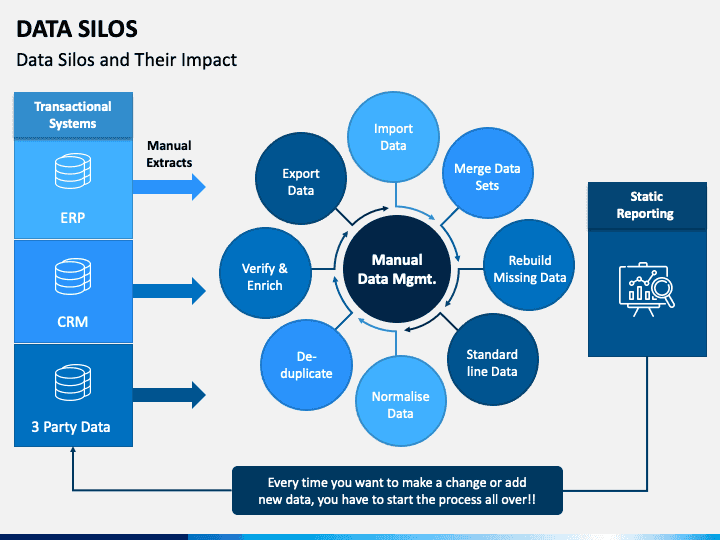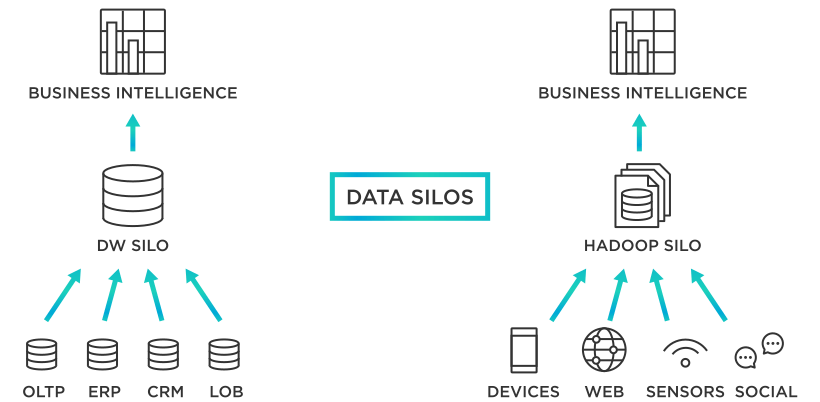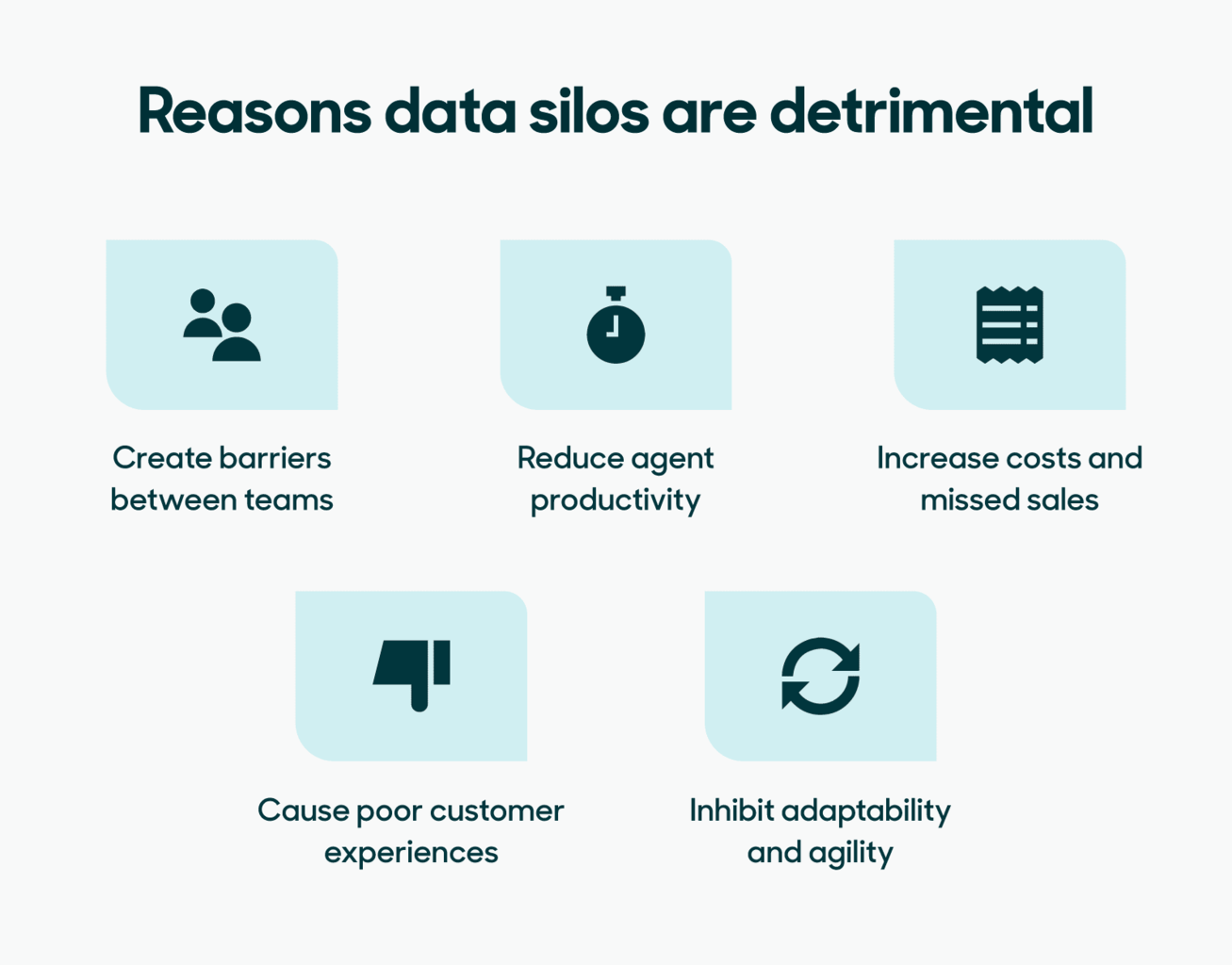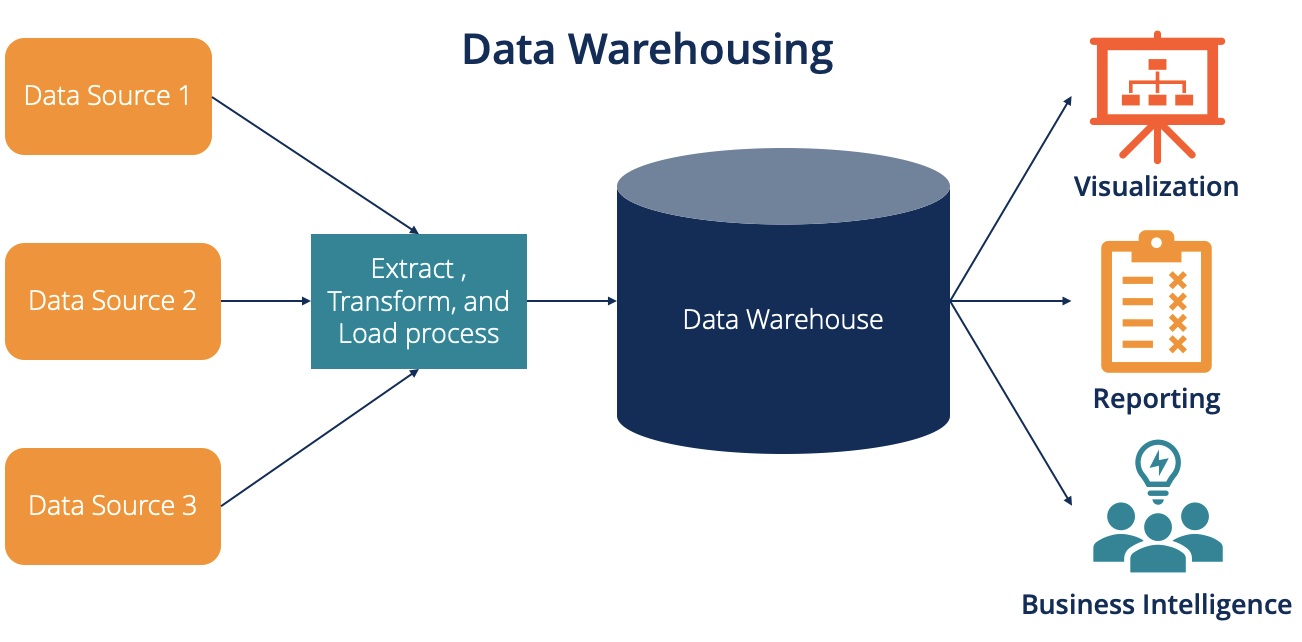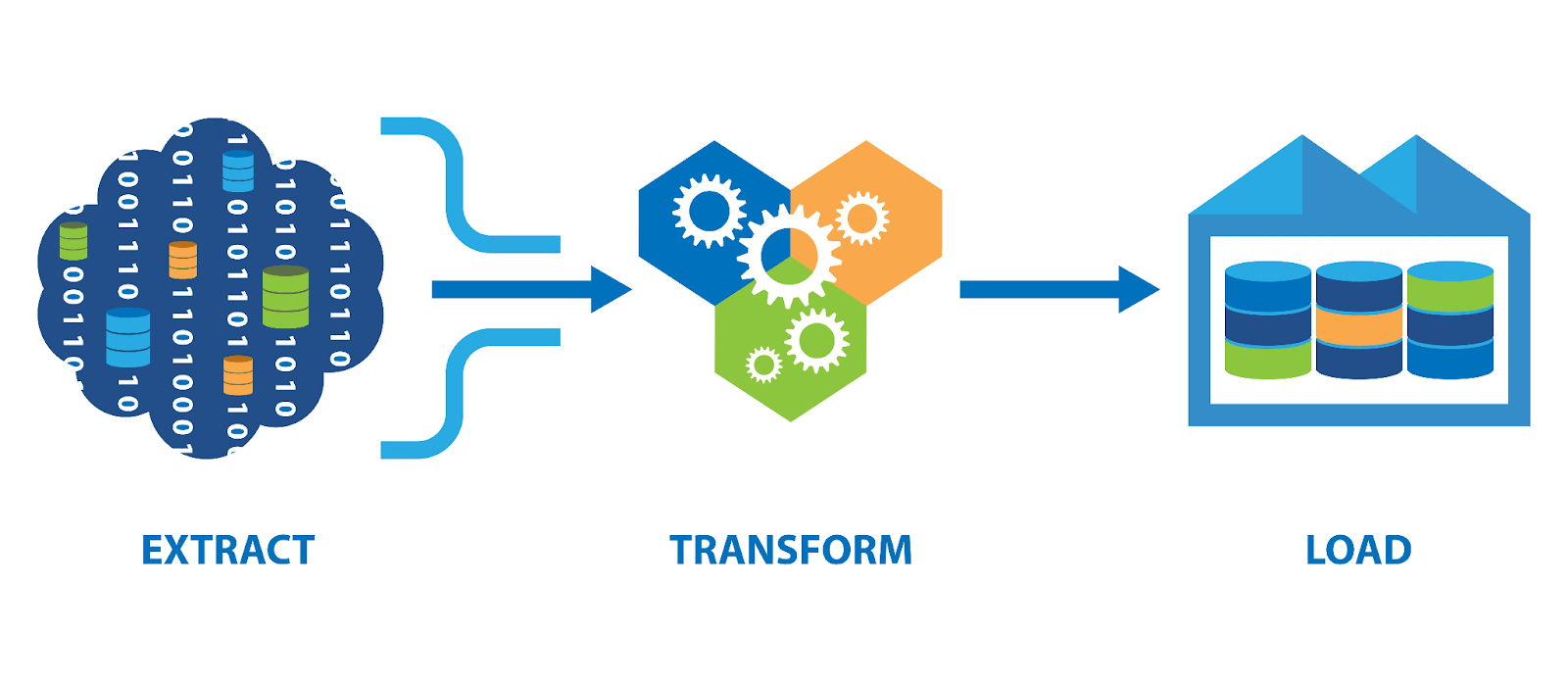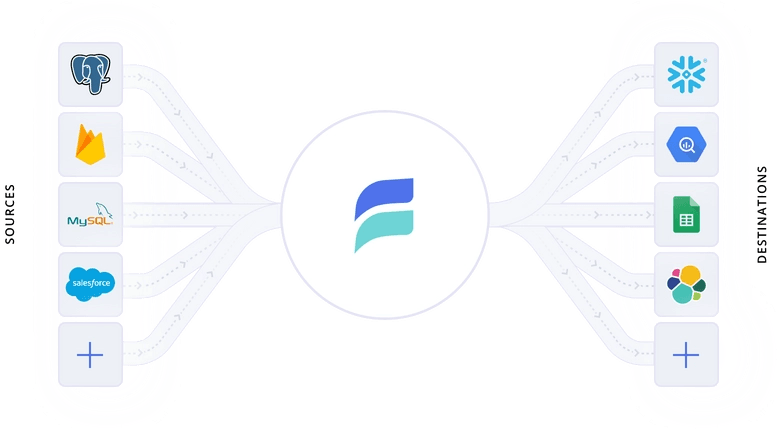Data silos are a major obstacle for modern businesses that rely heavily on accurate and up-to-date data. They are more than just a nuisance – they have significant negative consequences for your business. Inefficiency, inaccuracies, missed opportunities, reduced competitiveness, and the list goes on. But why are data silos problematic?
On the face of it, data silos are problematic because they limit the flow and accessibility of information within an organization or system. But this is just a small part of the bigger picture. There's a lot more going on beneath the surface which we will discuss in today’s guide. We’ll see what data silos are, why are they formed, and give you 8 reasons why they are bad for your organization.
By the end of this guide, you’ll not only have a solid understanding of the risks associated with data silos but also know the 5 real-world solutions for breaking them down.
What Are Data Silos?
Data silos are separate collections of data within an organization that only one group can access. When different groups within an organization withhold their information, it makes it challenging for everyone to work together and use the data effectively.
Data silos can occur for several reasons. Using different data management systems which aren’t integrated or connected can create data silos. Or they can be because of company culture or structure, particularly in larger organizations where teams might not communicate as effectively.
So why is this an issue?
When data is kept separate, it’s harder to get a clear, unified view of business operations, customer interactions, or any other area of business. This causes a lot of problems which we discuss next.
Why Are Data Silos Problematic?
With data silos, it’s not just you who suffers, your customers do too. They get stuck with long waits, countless transfers, and repeating themselves over and over.
Let’s see some of the major problems with data silos in more detail starting with the impact of data silos on productivity and agent performance.
Negative Impact On Productivity & Agent Performance
When data is locked away in silos, it becomes difficult for teams to access the information they need to do their jobs effectively. This can result in inefficiencies, reduced productivity, and increased costs.
Here’s the rundown:
- Inefficient Communication: When data isn't centrally accessible, it causes inefficient communication. This results in repeated requests for information, misunderstandings, delays, and errors in decision-making.
- Reduced Productivity: Data silos reduce productivity as team members spend valuable time, up to 12 hours every week, searching for data across multiple systems.
- Poor Agent Performance: Agents without access to complete data can’t perform their best. When agents don’t have the complete picture, the outcome won’t be as good as it could be.
- Lack of Cross-Functional Collaboration: With siloed data, departments can become isolated. This hinders cross-functional collaboration which is a must for innovation and problem-solving.
Inefficient Resource Utilization: Costs & Redundant Data Storage
Data silos also cause inefficient resource utilization, adding to the costs of a business and creating missed opportunities. According to IDC Market Research, your business might be losing up to 30% of revenue because of inefficiencies.
Here are some specific ways that data silos can cause these problems:
- Higher Costs: Maintaining multiple data silos can be costly. Each silo needs separate maintenance, management, and hardware resources.
- Redundant Effort: When data is stored in silos, teams might unknowingly be working on the same data which results in a waste of time and human resources.
This is how redundant data storage negatively impacts your business:
- Increased Complexity: Every extra silo adds another layer of complexity to your data management.
- Wasted Storage Space: Storing data that is similar in different silos means you’re using up more storage than necessary.
- Data Synchronization Issues: With redundant data storage, syncing changes across all silos becomes a nightmare.
Data Integrity & Governance Challenges
Data silos have a major impact on data integrity and governance resulting in a range of challenges for businesses. Here are some of the key issues:
- Conflicting Data: When data is siloed, it’s common to find discrepancies. One department might have different data than another for the same customer. Inconsistent data generates incorrect conclusions, and in turn, poor decision-making.
- Data Decay: Siloed data is often not updated uniformly across all systems. This results in stale, outdated information, causing what we call data decay. Data decay can mislead your strategies and plans.
- Duplication of Data: Duplication is another big problem. The same data stored in different places causes redundancy and a waste of resources.
- Compliance Risks: Data silos make it tough to maintain compliance. If the data is not uniformly managed, you would unknowingly violate regulations and have to face hefty fines and a tarnished reputation.
- Lack of Control: It’s hard to manage and govern data effectively when it’s scattered all over the place.
Adverse Effects On Customer Experience & Journey Tracking
One massive consequence of data silos is the negative impact on customer experience. Here’s how:
- Inadequate Information: Data silos can leave customer service agents in the dark. They lack the complete customer information required to provide personalized service. This causes customer frustration and decreased satisfaction.
- Delayed Response: Agents spend more time hunting for necessary information across various systems. The results are longer wait times, customer dissatisfaction, and potential loss of business.
- Incomplete View: With data silos, you only see part of the customer journey. Imagine trying to complete a puzzle with missing pieces. That’s exactly what you’re doing when you attempt to understand the customer journey with siloed data.
- Missed Opportunities: Because you don’t have a complete view of the customer journey, you miss out on key touchpoints. These could be opportunities to engage, upsell, or simply make the customer feel valued.
Barriers To Effective Data Analysis: Inconsistencies, Fragmentation, & Incomplete Data Sets
Data silos cause inconsistencies, fragmentation, and incomplete data sets which create barriers to effective data analysis. This will flaw decision-making, reduce productivity, and miss sales opportunities, among other problems.
Here are some of the specific ways that data silos are problematic for businesses:
- Inconsistencies: When data is stored in a silo, it is not consistent with other data sets. Because of this, users of both operational and analytical applications experience problems with data quality, accuracy, and integrity.
- Fragmentation: Data silos cause fragmentation since the data is spread across multiple systems and is difficult to access and share. This duplicates effort, decreases productivity, and misses sales opportunities.
- Incomplete Data Sets: Siloed data can also lock away data from users who don’t have access to them. Since not all relevant information is considered, business choices are off the mark.
Hindrance To Business Adaptability, Agility, & Strategic Alignment
Data silos cause significant harm to businesses by hindering their ability to adapt, be agile, and align their strategies. Let’s talk about each of these:
- Business Adaptability: In a dynamic business environment, quick and informed adaptations are key to survival. Data silos limit access to necessary information, limiting your ability to respond to changes effectively.
- Agile Decision Making: Effective and quick decision-making relies on comprehensive, accurate, and easily available data. Data silos, by their very nature, create fragmented and incomplete information landscapes. This results in ill-informed decisions and even delay decision-making, negatively impacting business outcomes.
- Strategic Alignment: For a business to thrive, all departments should align with the overarching strategy. Data silos create information gaps between departments and disrupt this alignment. This discord causes misunderstandings, missed opportunities, and overall inefficiency.
Security Challenges In Data Management
Data silos indeed pose a significant threat to your organization’s data security. Let’s discuss why that is.
- Data Security: When data is scattered across multiple silos, it’s harder to maintain a strong security posture. Each silo can become a potential weak point, susceptible to breaches.
- Increased vulnerability: Data silos create multiple entry points for potential security breaches. Each silo becomes a separate target for cyberattacks and increases the organization's vulnerability to data breaches, unauthorized access, or malicious activities.
- Lack of visibility: Data silos make it difficult to gain a comprehensive view of the organization's data security landscape. Without a centralized data management system, it is challenging to monitor and track security incidents or detect patterns across different silos. This hampers your ability to respond quickly to security threats or identify potential vulnerabilities in the data infrastructure.
Organizational Culture Issues: Transparency & Trust Deficits Among Teams
Data silos can greatly affect transparency in your organization. They:
- Keep critical information out of reach.
- Prevent teams from seeing the bigger picture.
- Foster a culture of secrecy rather than openness.
When data silos creep in, they can also create trust deficits among teams. It’s like building walls instead of bridges. They:
- Reduce collaboration and synergy.
- Encourage a ‘hoard and hide’ mentality.
- Cause misunderstandings and missed opportunities.
Yes, we now know how big of a problem these data silos are. But hang tight, we’ll get to the solutions in the next section.
How To Break Down Data Silos? 5 Proven Strategies
Let’s get to the good part - how do we fix this silo problem? Here are key strategies you can employ for eliminating data silos:
Set Up Solid Data Management & Business Structures
Here’s a big one – breaking down data silos involves putting in place strong data governance and organizational frameworks. With proper data governance, you ensure that everyone is on the same page about how data should be handled.
Here’s what you’ll do:
- Standardize Your System: Create a system that’s consistent throughout your team. It will facilitate smoother communication, enhance teamwork, and ultimately lead to more informed and efficient decision-making across the board.
- Centralize Your Data: Ensure all your business data stays in a single, easy-to-access spot. This prevents any data from falling through the cracks.
- Metadata Management: This helps you organize your data effectively. By keeping track of what data you have and where it is, metadata management makes your data easily searchable and accessible
Use Data Warehouses, Data Lakes, & Cloud Solutions
Data warehouses, data lakes, and cloud-based solutions play a key role in centralizing your data. This not only gives your analysts a complete view of the company but also makes collaboration between departments a breeze. Plus, it’s a solution that can grow with your business.
In our world where remote work is getting more and more common, cloud solutions mean your data is always at your fingertips, no matter where you are. This makes sharing and collaborating on data super easy. Here’s how these tools can help:
Data Warehouses and Data Lakes:
- Provide a centralized hub for all your data.
- Provide scalability to match your company’s growth
- Promote team collaboration by making data easily accessible to all.
Cloud Solutions:
- They further encourage data sharing and teamwork.
- They offer convenient access to data from anywhere, anytime.
Embrace Data Integration Techniques
One surefire way to break data silos is by opting for data integration methods ensuring that the data is correctly and effectively unified. With these methods, you can move your data into a central storage solution, like a data warehouse.
Here are some methods to achieve this:
- Scripting: This is the traditional way where you write scripts to move data from different data sources into one place.
- On-premises ETL Tools: ETL stands for Extract, Transform, Load. It’s a process that pulls data out of one database, modifies it, and then loads it into another database. With on-premises ETL tools, you handle this process using your own servers and systems.
- Cloud-based ETL: This is the same ETL process but it’s managed in the cloud. The cloud provider takes care of the heavy lifting.
Use AI For Data Handling
Artificial Intelligence is more than just a tech industry catchphrase. It’s rapidly becoming an indispensable asset for data management and analysis. Here’s how AI can help us bust those pesky data silos:
- Around-the-Clock Assistance: With AI on your team, you get a tireless worker. It’s on duty 24/7, always ready to help.
- Quick Fixes: AI can speed up problem-solving and provides faster solutions and saving you precious time.
- Reduced Human Errors: AI isn’t prone to those little slips we humans sometimes make. This means fewer errors in your data management.
- Personalized Recommendations: AI can sift through your data, analyze it, and offer tailored advice.
- One-Stop Data Tracking: With AI, you can gather all your data under one roof. No more hide and seek with your data.
Master Customer Experience
To truly crack data silos, you will have to master your customer’s journey. This means picturing all the ways they interact with your brand and identifying the essential data to boost each touchpoint.
But don't forget, each company’s journey is unique, so focus on defining your key objectives.
Then engage your support team. They’re crucial in delivering this perfect experience. Identify the data they need and find out where the gaps are between departments. Start by looking into the issues your agents face the most.
Think about:
- The tools your agents keep switching between.
- The resources that could quicken problem-solving.
- The strategies to cut down on handling time and increase efficiency.
The goal? Not to drown your team in data but to pinpoint exactly what they need to resolve issues quicker.
How Can Estuary Help?
When you’re looking to tackle the problem of data silos, you need a tool that’s up to the task.
Enter Estuary Flow, our dynamic ETL solution that can streamline your data integration efforts. Let’s see how Flow can help:
- Reliable Accuracy: Estuary’s built-in testing ensures your data’s on point.
- Simplified Data Capture: Estuary grabs data from many different types of sources - databases, SaaS applications, you name it.
- Scalable Solutions: Estuary offers flexible and adaptable solutions that can handle data volumes ranging from gigabytes to terabytes.
- Real-time Transformations: With Estuary’s SQL and TypeScript transformations, you can turn that messy data into something meaningful.
- Fresh Data Views: Estuary’s real-time materializations keep your data views fresh, so your teams always work with the most up-to-date data.
Conclusion
Data silos occur and they are a big problem for many organizations. These isolated pockets of data not only hinder efficient decision-making but also impede collaboration and the ability to gain valuable insights.
Why are data silos problematic? The consequences of a data silo can be felt throughout the entire organization, causing missed opportunities and an incomplete understanding of customer data.
That’s where Estuary comes into the picture. Our platform, Flow, provides robust data integration capabilities that can help you break down these silos and ensure a seamless flow of information across your organization.
If you're ready to take the next step in your data integration journey, sign up today or contact us to discuss how we can help.


